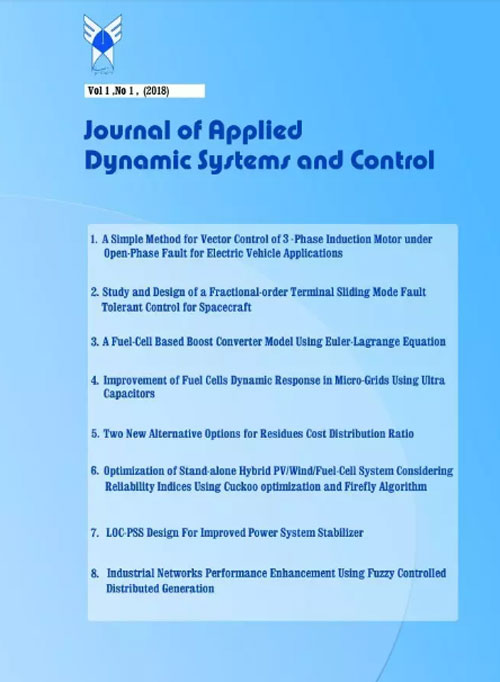فهرست مطالب

Journal of Applied Dynamic Systems and Control
Volume:5 Issue: 1, Winter and Spring 2022
- تاریخ انتشار: 1401/03/11
- تعداد عناوین: 10
-
Pages 1-4Renewable energies, in addition to being inexhaustible, are among the clean energies and do not pollute the environment. Among renewable energies, solar energy is of special importance due to its extent and scope of application. In this article, the feasibility of building a photovoltaic power plant connected to the grid has been studied at the desired location, which selects the appropriate capacity and angle for the optimal use of solar power by the plant and reduces costs. Networking is very useful. In this paper, the feasibility study of a photovoltaic power plant with a capacity of 23.76 kW in Haftkol city, considering equipment, modules, power, voltage, inverter, optimal use of area and high reliability, has been designed using software. Land with an area of 144 square meters with an efficiency of 84.65% and 88 photovoltaic panels is considered and also the annual injection capacity to the network is 42350 MW.Keywords: Solar Energy, Pv syst, Photovoltaic system
-
Pages 5-10today, the use of different types of industrial robots is developing due to the growth of technology and the expansion of research in design and control. Industrial robots are a fundamental component of most modern automation systems. In this paper, we study the dynamic modeling and adaptive control of flexible joint robots (FJR). In this regard, the dynamic model of the robot will be extracted in state space using the Lagrange-Euler method. A new adaptive backstepping control approach is introduced to control FJR motions and improve the adaption and robustness of the nonlinear system. By using this method, variations of the model parameters will not affect the robust performance of the proposed controller. To evaluate the proposed method, MATLAB software is used to simulate a 2-joints FJR model with an adaptive backstepping controller. Based on results the proposed method controls the model property without overshoot, by considering the saturation limit of input control.Keywords: Flexible robot, nonlinear model, Adaptive controller
-
Pages 11-20The spread of the smart grid has led to the widespread penetration of small-scale distributed energy resources. Distributed generations (DGs) include conventional small-scale power plants and renewable energies with no pollutant emission. This paper presents two-stage stochastic planning for the participation of a virtual power plant (VPP) in energy and reserve markets in the presence of demand response (DR) programs. The proposed VPP consists of various power generation sources, including wind turbines, photovoltaics (PV),combined heat and power (CHP) units, microturbines, and boilers; power storage sources, including battery storage systems (BSS) and thermal buffer tank (BT); and also energy consumers, including electric vehicles (EV) and end consumers.The designed VPP enables participation in these markets by aggregating DERs. Probability distribution functions are applied to generate scenarios based on the existing uncertainties in renewable energy generation, energy price, and consumer demand. The number of possible scenarios is reduced using a scenario reduction technique. Two-stage stochastic planning is proposed to manage the designed VPP. The results suggest that participation in DR programs leads to a considerable increase in optimal operational profit of the VPP. Keywords: Demand Response, Virtual power plant, distributed generations, Renewable energies
-
Pages 21-25Photonic crystal fibers (PCFs) are widely used in optical industries and telecommunication systems as a low dispersion and structural losses with low nonlinear coefficient. Photonic crystals are media where their refractive index distribution function is periodic or non-periodic. A manifest property of photon crystals is the presence of a band-gap in the signal transmission spectrum. Electromagnetic detection with frequency range in the band range is not prohibited. Hence, the electromagnetic waves with a frequency range in the band-gap cannot be propagated. In this paper, the dispersion property of silica core photonic crystal fibers is analyzed for three and six-ring air hole structures. It is illustrated that the six-ring air hole structure shows satisfactory results in our design. Also, considering the holes filled with concentrated silica with fluorine materials, GeO2, P2O5, and B2O3 instead of air holes, it has been shown that the diffusion properties will have significant differences. The results obtained from simulations are shown by comparing with pure silica crystal.Keywords: photonic crystal fiber, Dispersion Characteristic, Dopant Concentration, Air Hole Rings
-
Pages 26-30In this study a new type of fault current limiter is introduced. It has been named multi-functional capacitive fault current limiter (MCFCL). as a variable capacitor, its function is to control active power flow in normal conditions as well as improving the capability of low voltage rid-through (LVRT) in fault operating conditions. The new structure has been proposed based on the capacitive bridge-type fault current limiter (BFCL) and the RL-type fault current limiter (FCL), which is modified to enhance low-voltage ride-through capability. To assess the efficacy of proposed fault current limiter, the time domain simulations were executed in PSCAD/EMTDC software and its function is compared with the RL-type SSFCLs in normal and symmetrical or asymmetrical fault conditions. Also its efficacy has been evaluated in a fixed speed based wind farm. The result of simulations showed that the MCFCL is not only able to control the power flow in normal operating condition, but also improves the LVRT performance in fault operating condition in the wind farms.Keywords: Capacitive Fault Current Limiter, LVRT, Wind farm
-
Pages 31-37
The complexity of communication and the size of different areas of power systems are increasing, and the development of the power system requires the optimal allocation of electric power produced by a large number of system generators. Electric energy production in power systems is one of the most important issues in modern systems, along with minimizing the total production cost of the generator units in the power system. Economic load distribution is a common optimization problem in power systems. In this article, the economic distribution of the load between the production units has been done by limiting the minimum and maximum power range between the generator units. To carry out the economic distribution of the load, the repetition method of the Lagrange coefficient is used. To show the study data, the simulation results for a power system with two production units and taking into account losses and a power system with three production units and without losses are presented. Distinct fuel functions are considered for the units in the study.
Keywords: Economical Load Distribution, Optimization, Lagrange Coefficients, Thermal Plant -
Pages 38-49In the present research, the flexural and compressive behavior of foam-filled sandwich panels M-shaped core with hybrid carbon-glass fiber composite have been experimentally investigated. In order to fabricate the sandwich panels, the vacuum assisted resin transfer molding (VARTM) has been used to achieve a laminate without any fault. Afterward, polyurethane foam with density of 80 Kg/m3 has been injected into the core of the sandwich panel. The flexural and compressive properties of sandwich panel with hybrid carbon-glass fiber [CGCG]s have been compared to those of eight-layered carbon fiber [C]8 and the eight-layered glass fiber [G]8. The study of force-displacement curves obtained from the compressive and three-point bending tests showed that the [CGCG]s has larger elastic region than [C]8 and larger plastic region than [G]8. Also, it was found that polyurethane foam enhanced the ultimate compressive and bending loads and absorber features of sandwich panels Finally, the extra foam coming out of the sides of the sandwich panel is cut after rigidization.Keywords: Sandwich panel, Hybrid, Flexural behavior, compressive behavior, Polyurethane Foam
-
Pages 50-55
Magnetic nanoparticles were synthesized and coated by the situ-coprecipitation method with FeCl3.6H2O and FeCl2.4H2O precursors in the presence of NH4OH (or NaOH) reduction and PEG coated agent. Preparation of modified magnetic nanoparticles were performed at two different temperatures under the influence of different alkaline media. The effect of strength of alkaline media and reaction temperature of the magnetic properties (Magnetic saturation, Magnetic remanent, coercive force (of modified MNPs were investigated. To study structure, morphology, optic and magnetic properties MNPs were characterized by XRD, FTIR, TEM and VSM analyzes.The results showed that modified magnetic nanoparticles have superparamagnetic properties and have high magnetic saturation and small coercive force, so the magnetic properties of the modified MNPs are depended to the strength of the alkaline remanent directly. The saturation magnetization of the synthesized sample in NH4OH and NaOH at 80° C was determined as 60.94 and 49.39 emu/g, respectively. Also increasing temperature, improves magnetic properties coated MNPs) at temperatures below the blocking temperature. (The results of the XRD analysis showed that the structure of the modified magnetic nanoparticles is inverted spinel and the size of the nanoparticles synthesized in the ammonia media is smaller than the other media. The results of FTIR optical analysis revealed that the peaks at ~570 and ~440 cm^(-1) indicates the bond Fe-O. TEM analysis indicated that the shape of the MNPs is pseudo-spherical. VSM analysis indicated that the magnetic nanoparticles synthesized in stronger alkaline media (ammonia) and high temperature showed better magnetic behavior by higher magnetic properties.
Keywords: Magnetic nanoparticles, Superparamagnetic, Magnetic properties, Magnetic Saturation -
Pages 56-63Improving voltage stability is one of the most critical issues in evaluating the performance of power systems. Whereas the use of distributed generation resources in distribution networks plays an important role, the optimal sitting and sizing of these units are vital for improving voltage stability and reducing losses. Distribution systems are known to be substantially unbalanced, so a three-phase power flow is required as an efficient tool for unbalanced network analysis. This paper presents a new voltage stability index with simple updating that can update just by active and reactive power demand in each iteration of power flow. Also, in order to find the optimal siting and sizing of distributed generation units (DGs), the voltage stability is analyzed by considering the Imperialist Competition Algorithm (ICA). The obtained results show the improvement of voltage profile and voltage stability as well as the reduction of total losses in the IEEE 34 bus multiphase distribution system.Keywords: Voltage stability, Backward, forward load flow, Imperialist competition algorithm, distributed generation, Multiphase distribution systems
-
Pages 64-67
We have calculated the branching ratio of the non-resonant B→D^- π^+ π^+ π^- four body decay using a simple model based on the framework of the naïve factorization approach where one can ommit the nonfactorization effects. In naive factorization approach, according to the Feynman diagram, there are only two tree diagrams for this decay mode. In the first diagram, the matrix element of decay mode is factorized into a B→D form factor multiplied by a 3π decay constant and in the second diagram, the matrix element is factorized into a B→Dπ form factor multiplied by a 2π decay constant, According to the rest mass of the particles, we assume that in the rest frame of B meson, the D meson remains stationary, so we obtain the value (3.47±0.14)×10^(-3) for the branching ratio of the B→D^- π^+ π^+ π^- decay mode in naive factorization approach, while the experimental results is (3.9±1.9)×10^(-3).
Keywords: B meson, four body decay, branching ratio, naive factorize


